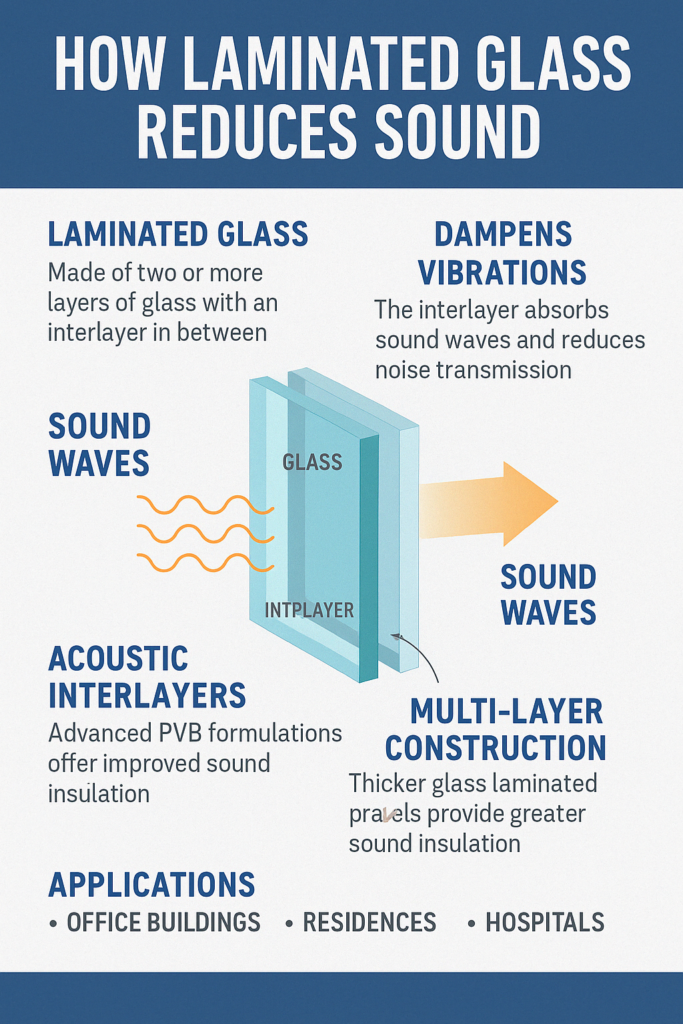In today’s world of open-plan architecture and urban noise, acoustic comfort is a growing priority. Whether it’s for residential quiet zones, corporate offices, or hospitals, laminated glass is becoming a key material in soundproofing design. But how exactly does laminated glass reduce sound?
This article explores the acoustic properties of laminated glass, its structure, effectiveness compared to other glazing, and how it improves both performance and aesthetics in modern construction.
What Is Laminated Glass?
Laminated glass, or glass laminated, is a type of safety glass formed by bonding two or more layers of glass with a plastic interlayer—usually PVB (polyvinyl butyral) or EVA (ethylene vinyl acetate). This interlayer is central not only to its safety properties but also to its ability to absorb and reduce sound waves.
When sound waves hit a surface, they transmit, reflect, or are absorbed. The soft interlayer in laminated glass disrupts sound transmission by absorbing vibrations between glass panes, making it significantly more sound-resistant than ordinary glass.
🔗 Related article: Laminated Glass Prevents Injury
How Laminated Glass Reduces Sound
1. Dampening Vibrations
The interlayer inside laminated glass is flexible and viscoelastic. It absorbs and dissipates the sound energy rather than letting it pass through, reducing airborne noise.
2. Acoustic Interlayers
Standard laminated glass already blocks some sound, but specialized acoustic laminated glass uses advanced PVB formulations for enhanced performance. These are especially effective in:
- Hospitals
- Sound studios
- Airports and train stations
- Office meeting rooms
3. Multi-Layer Construction
Laminated glass can include more than two layers (e.g., triple-laminated panels), offering greater sound insulation. The more layers and thicker the interlayer, the better the Sound Transmission Class (STC) rating.
Example STC Ratings:
- Single-pane float glass: 27–30
- Standard laminated glass: 35–37
- Acoustic laminated glass: 40–45
- Double-glazed with acoustic lamination: Up to 50+
Where Soundproof Laminated Glass Is Used
Laminated safety glass is widely used for its acoustic benefits in various environments:
- Residential Buildings
- Urban apartments near highways or airports
- Interior partitions for quiet rooms
- Commercial Spaces
- Office facades
- Glass conference rooms
- Retail storefronts in noisy areas
- Healthcare and Hospitality
- Hospitals, clinics, and therapy rooms
- Hotel windows and sliding doors
- Educational Institutions
- Libraries and study zones
- Administrative offices
Why Choose Laminated Glass for Sound Control?
1. Better Than Double Glazing Alone
Standard double glazing traps air between two panes but may not be enough in high-noise zones. Adding a laminated acoustic layer significantly enhances sound insulation.
2. Safety + Soundproofing in One
Instead of installing separate safety glass and acoustic barriers, glass laminated panels do both—making them space-saving and cost-efficient.
3. Consistent Design Aesthetics
Noise insulation doesn’t require bulky walls or unattractive materials. Laminated glass offers a clean, modern look that avoids:
- Composition imbalance
- Inconsistent lighting
- Flat perspective in interiors
Laminated Glass vs Other Soundproofing Glass
| Feature | Laminated Glass | Tempered Glass | Standard Double Glazing |
|---|---|---|---|
| Sound Insulation | High (with interlayer) | Low | Moderate |
| STC Rating | 35–45+ | 27–30 | 30–35 |
| UV/Noise Combo Protection | Yes | No | Limited |
| Post-break Safety | Excellent | Good | Poor |
Laminated Glass Price for Acoustic Applications
The laminated glass price varies depending on thickness, size, interlayer type, and customization.
Average Pricing:
- Standard laminated glass: $25–$40/m²
- Acoustic laminated glass: $45–$65/m²
- Multi-layer acoustic panels: $60–$90/m²
To get accurate estimates, always consult laminated glass manufacturers or fabricators who specialize in acoustic glazing.
Additional Acoustic Glazing Options
To improve results further, laminated glass can be paired with:
- Asymmetric double glazing (panes of different thicknesses)
- Laminated + Argon-filled insulated glass units (IGUs)
- Thermally broken frames to reduce structural noise transfer
Related Search Keywords to Target
- does laminated glass reduce noise
- best glass for soundproofing
- laminated acoustic glass panels
- price of laminated glass for soundproofing
- laminated vs tempered glass noise
- laminated glass manufacturers for soundproof windows
- laminated safety glass with acoustic rating
- acoustic interlayer laminated glass
- glass laminated for quiet rooms
- what is laminated glass used for in sound control
Conclusion
Laminated glass is a powerful solution for reducing noise while also improving safety, thermal performance, and visual clarity. Its versatility makes it a favorite in both residential and commercial projects that demand peace, performance, and polished design.
From quiet homes to high-end offices, laminated glass ensures that comfort and quiet go hand in hand.

